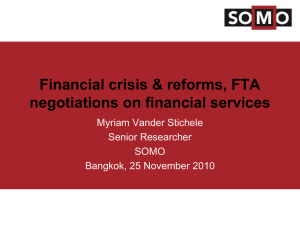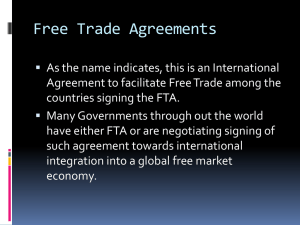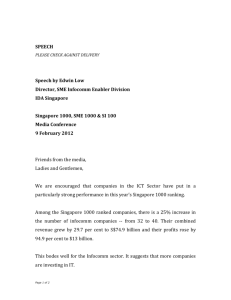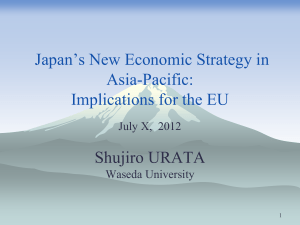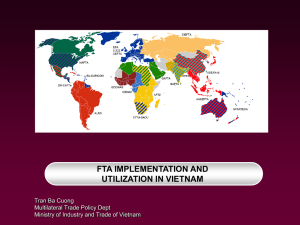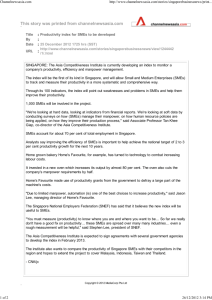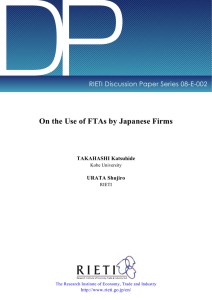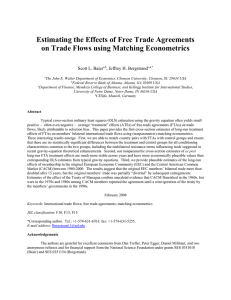Free Trade Agreements (Trade in Goods)
advertisement
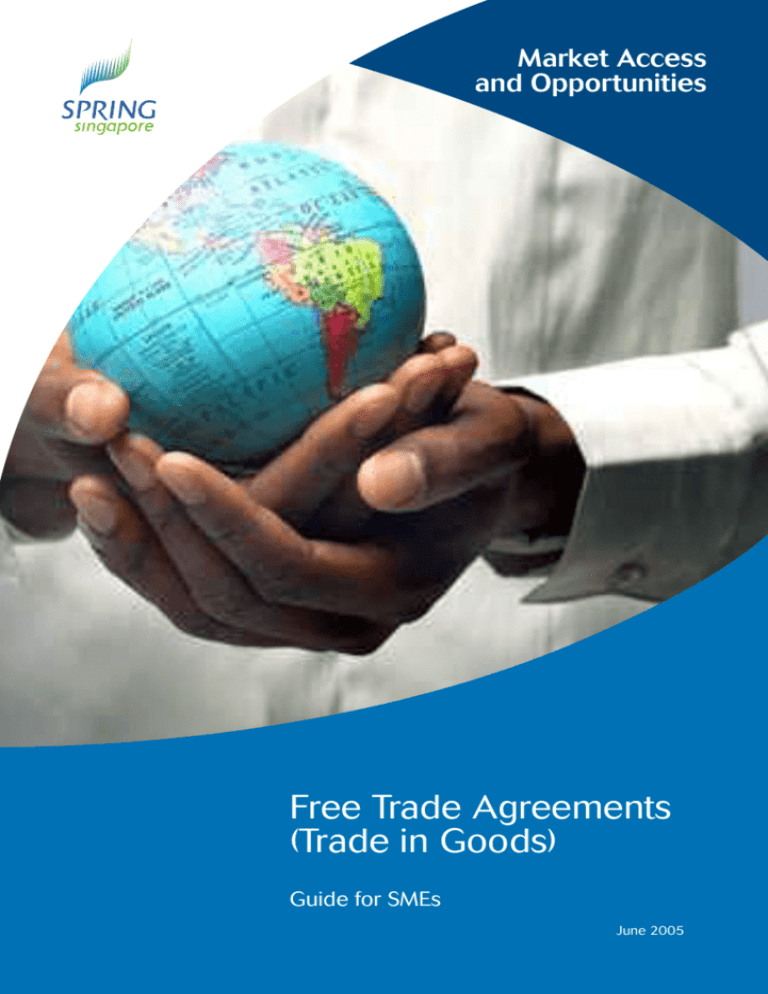
Market Access and Opportunities Free Trade Agreements (Trade in Goods) Guide for SMEs June 2005 INTRODUCTION Free Trade Agreements (FTAs) aim to remove the barriers to trade and investment. They create a freer flow of goods, services, investment and people. Within our FTAs, Singapore businesses will find it easier to trade with our FTA partners and to invest in their markets. FTAs also present business opportunities for SMEs to enhance their market access. SPRING Singapore is reaching out to SMEs to help them understand FTA Rules and acquire the know-how to comply with the FTA requirements. This Guide provides some basic information to SMEs on Trade in Goods and aims to help exporters understand and benefit from FTAs. ISBN 981 4150 08 8 Copyright © 2005 by Standards, Productivity and Innovation Board Singapore’s FTA Network * European Free Trade Association Canada Korea USA Jordan Egypt Kuwait Bahrain Pakistan Qatar India UAE Panama Sri Lanka Japan China ASEAN Peru Australia South Africa Chile New Zealand FTAs signed / in force FTAs under negotiation • ASEAN • ASEAN & People's Republic of China (Trade in Goods) • Australia • European Free Trade Association (EFTA – comprises Switzerland, Iceland Liechtenstein and Norway) • Hashemite Kingdom of Jordan • India • Japan • New Zealand • Trans-Pacific Strategic Economic Partnership Agreement (Brunei, Chile, New Zealand, Singapore) • United States • ASEAN & CER (New Zealand & Australia) • ASEAN & India • ASEAN & Japan • ASEAN & Republic of Korea • Canada • Kuwait • Panama • Peru • Qatar • Republic of Korea • Sri Lanka FTAs in the Works • • • • • Bahrain Egypt Pakistan South Africa United Arab Emirates (UAE) * Please refer to the FTA website at http://www.fta.gov.sg for the latest update Free Trade Agreements (Trade In Goods) Guide for SMEs 01 What is an FTA ? Why do we have FTAs ? A free trade agreement (FTA) is a legally binding agreement between two or more countries to liberalise trade and bring about closer economic integration. FTAs allow the partners to give each other preferential market access. Thus, FTAs help to foster and facilitate the flow of trade and investment between Singapore and its trading partners. 02 Free Trade Agreements (Trade In Goods) Guide for SMEs What areas of trade liberalisation are covered in an FTA ? The three basic pillars of liberalisation are Trade in Goods, Trade in Services and Investment. In addition, FTAs may cover protection of intellectual property rights, government procurement and dispute settlement. FTA Framework Trade In Goods Trade In Services Investments • Remove tariffs • Market Access • Remove non-tariff barriers • National Treatment • Protect & promote investments Intellectual Property Government Procurement Dispute Settlement Free Trade Agreements (Trade In Goods) Guide for SMEs 03 TRADE IN GOODS This guide aims to help exporters understand and benefit from FTAs Who will benefit from FTAs ? Manufacturers and exporters whose products qualify for preferential tariffs will benefit. Their products can be more competitive due to lower tariffs. Can every product exported from Singapore qualify for preferential tariffs? No. Preferential tariffs are only awarded to goods that meet the Rules of Origin (ROO) stated in the FTAs. What are “Rules of Origin” ? Only goods originating from Parties of a Free Trade Agreement (FTA) can benefit under the FTA. To ensure this, Rules of Origin (ROO) are put in place to determine the nationality of the goods. To qualify as originating, goods must either be wholly obtained or produced, or for manufactured products, the main principle behind the concept of ROO is that the country of origin is the last country where substantial transformation took place. 04 Free Trade Agreements (Trade In Goods) Guide for SMEs The Three Main Criteria Of “Substantial Transformation” 1. Change in Tariff Classification (CTC) Rule The final product must have a different tariff classification (HS Code*) from that of imported or non-originating raw materials used in its manufacture. CTC must occur in Singapore. *HS Code refers to the Harmonised Commodity Description and Coding System Nomenclature Example: Product : Beer (HS Code heading: 2203) Rule of Origin : “Production from materials other than from those of heading 2203” Water Malt (imported) Other inputs (imported) Beer 1107 1302, 2102 2203 (1107, 1302, 2102 and 2203 are HS Codes of the inputs and final product) The imported or non-originating inputs undergo the requisite change in tariff classification in Singapore. The Final product is therefore deemed substantially transformed and is a Singaporean product. 2. Value Add (VA) Rule, i.e. Local Content Rule Local content must be above the qualifying threshold. Example: Product : Beer Rule of Origin : “Local content must be at least 50% of ex-factory cost” Water Malt (imported) Other inputs (imported) Manpower Overheads Beer $1 $2 $2 $3 $2 $10 Total ex-factory cost = $10 Local content: $1 (water) + $3 (manpower) + $2 (overheads) = $6 Since the local content is 60% of the ex-factory cost, i.e exceeds the minimum threshold of 50%, beer meets the VA rule and qualifies as a Singaporean product. Free Trade Agreements (Trade In Goods) Guide for SMEs 05 ... Continued 3. Process Rule The defining manufacturing process which characterizes the product must occur in Singapore. Example: Product : Beer Rule of Origin : Fermentation must occur in Singapore Water + Malt + Other inputs Beer fermentation The process of fermentation occurs in Singapore, so beer meets the process definition and qualifies as a Singaporean product. Any one rule or combination of rules could be applied depending on the country of export (See Table below). Determining Rules of Origin Rules of Origin (ROO) Change in Tariff Classification Rule (CTC) FTA Partners NZ EFTA* JAPAN AUSTRALIA USA NA ASEAN NA NA NA (for Textiles & Textile Products only) ASEAN-CHINA Value Add Rule (VA) Process Rule NA NA * European Free Trade Association 06 Free Trade Agreements (Trade In Goods) Guide for SMEs Verification of Origin and Documentation Requirements In order for the importer in an FTA-partner country to enjoy preferential tariffs, the Singapore exporter must certify that his goods meet the relevant Rules of Origin. This can be done either by self declaration by manufacturer or the exporter has to apply to Singapore Customs for an authorised Certificate of Origin. Documents relating to the origin status, production, shipment and sales of the exported goods should be kept for the number of years stipulated in the F TA (See Table below). Documentary Requirements FTA Partners Minimum Period of Record Keeping Documents Required NZ EFTA JAPAN AUSTRALIA USA ASEAN ASEANCHINA Exporter’s Exporter’s Authorised Authorised Importer’s Authorised Authorised Declaration Declaration Certificate Certificate Declaration Certificate Certificate of Origin of Origin & of Origin of Origin Exporter’s Declaration for 1st Shipment 4 years 3 years 3 years 5 years 5 years 2 years 2 years Free Trade Agreements (Trade In Goods) Guide for SMEs 07 WHAT YOU NEED TO DO TO BENEFIT FROM FTAs (for Trade in Goods) 1 Determine the F TA-partner country you are exporting to 2 Find out the HS code of the product you want to export 3 Check whether your product is included for tariff elimination 4 Determine whether your product qualifies as “Singapore-made” under the Rules of Origin 5 Determine documentation required (eg. Authorised Certificate of Origin or Self declaration) 6 Obtain required documentation and ship together with product 7 Product qualifies for tariff concessions 08 Free Trade Agreements (Trade In Goods) Guide for SMEs MORE INFORMATION FTA texts and guides to Rules of Origin http://www.fta.gov.sg HS Code of a product http://www.tradenet.gov.sg Application for Certificate of Origin http://www.tradenet.gov.sg General customs documentation enquiries Customs_documentation@customs.gov.sg Hotline: 6355 2000 General FTA enquiries MTI_ F TA@mti.gov.sg firststop@spring.gov.sg SME First Stop Hotline: 6898 1800 Source: Ministry of Trade and Industry and Singapore Customs Information correct at time of printing. SPRING Singapore 2 Bukit Merah Central Singapore 159835 Tel: (65) 6278 6666 Fax: (65) 6278 6667 Website: www.spring.gov.sg

